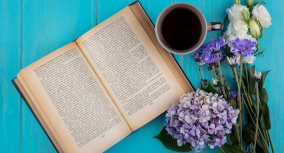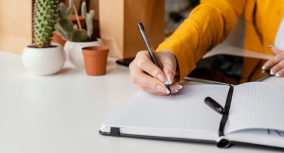Any literary analysis is a challenging task since literature includes many elements that can be interpreted differently. However, a stylistic analysis of all the figurative language the poets use may seem even harder. You may never realize what the author actually meant and how to comment on it!
While analyzing poetry, you should pay attention to the form of writing and its content. The purpose of this article by Custom-Writing.org experts is to give you a hand in understanding the rules and structure of poem analysis. First of all, there is some general information regarding the topic. Then, you will find a detailed step-by-step guide, followed by a poetry analysis essay example.

So, don’t worry, you can definitely rock this assignment! Knowing is half the battle, and practice is the other half!
❓ What Is the Purpose of Poetry Analysis?
Sometimes you may find yourself lost in the structural elements and metaphors of the poems. You start wondering what the purpose of poetry analysis is. Analyzing poems or other literary works requires more than just sharing opinions. It involves identifying themes and interpreting symbols hiding behind the used literary devices. For many students, balancing personal insights with the technical aspects of analysis can feel overwhelming.
If you’re struggling to connect these elements, our analytical essay writing service is here to support you. Whether it’s poetry, prose, or any other form of literature, we’re ready to provide you with a deeper understanding and an impressive essay to match.
👣 How to Analyze a Poem: Main Steps
The fact is that poetry has a lot of exciting stuff to offer. However, it can seem quite overwhelming when you don’t know where to begin. The secret tip is to break it down into small tasks. That is why we suggest you look through the following steps when you need to write a poem analysis essay.
📑 Poetry Analysis Essay: Outline
Nothing can help you with the writing process more than creating an outline for your poetry analysis essay. It can help you organize your ideas and thoughts better so that you don’t get lost. After completing the outline, the only thing you need to do is to follow the plan!
Finishing this part of the writing process is basically half of the job. After this, you can complete your paper in no time!
👀 Poetry Analysis Essay: Examples
Go through this example of a poem analysis essay to better understand how it should look. Note that the sample is structured according to the outline and the writing steps described in the above sections.
Poem Analysis Essay: A Dream Within a Dream by Edgar Allan Poe
Poem Analysis Essay Topics
- Analysis of art creation in two poems.
- Analyze Sonnet 18 by William Shakespeare.
- Stylistic devices used in the poem Daddy by Sylvia Plath.
- Discuss the theme of the poem Because I Could Not Stop for Death by Emily Dickinson.
- Analyze the distinctive features of the epic poem Sir Gawain and the Green Knight.
- Analysis of the poem The Double Image by Anne Sexton.
- Examine the devices used by Philip Larkin in The Explosion.
- Analyze the epic poem Iliad by Homer.
- The importance of rhythm in So, We’ll Go No More a-Roving by George Gordon Byron.
- Discuss the basic elements of Dulce et Decorum Est by Wilfred Owen.
- How Do I Love Thee by Barrett Browning: poem analysis.
- Analyze the religious poem Death Be Not Proud by John Donne.
- Discuss the importance of symbols in the epic poem Odyssey by Homer.
- Examine the women characters portrayed in Rich’s poem Women.
- Analyse the stylistic devices Wystan Hugh Auden uses to describe grief in his poem Funeral Blues.
- Interpret the use of free verse in Women by Alice Walker.
- Analysis of the poem Let America Be America Again by Langston Hughes.
- The Donkey by Gilbert Keith Chesterton: poem analysis.
- Describe the techniques Matsuo Basho uses to convey the splendor of nature.
- Compare the devices E. Dickinson, J. Donne, and A. Sexton use to present different attitudes towards death.
- Analyze rhetoric devices used in Gary Soto’s poems.
- Identify the core idea of the poem Root Cellar by Theodore Roethke.
- Reflection of the original culture in the epic poem Beowulf.
- Analysis of the poem Richard Cory by Edwin Arlington.
- Analyze the poem Daystar by Rita Dove.
- Analyze and compare the poems Heaven by Cathy Song and La Migra by Pat Mora.
- Return to childhood in poems by Hayden and Roethke.
- Analysis of Elizabeth Bishop’s poem One Art.
- Examine the main idea of Horace’s poem The Sacred Vine.
- Describe the means Brooks uses to express her ideas in the poem Primer for Blacks.
- Analyze the poem The White Man’s Burden by Rudyard Kipling.
- Compare how the authors describe relationships between children and fathers in Rhina Espaillat’s Bilingual/Bilingüe and Robert Hayden’s Those Winter Sundays.
- Analysis of the romantic poem Back to My Arms.
- Discuss the stylistic devices used to convey the emotions in poems about war by Borden, Owen, Grenfell and Seaman.
- Examine the importance of the structure in Poem for Haruko by June Jordan.
- La Belle Dame sans Merci by John Keats: poem analysis.
- Analyze the vocabulary used in Desert Places by Robert Frost.
- Describe the rhetorical devices in American Arithmetic by Natalie Diaz.
- Langston Hughes’ poetry analysis.
- The poetic features in Song of Myself by Walt Whitman.
- The main idea of The New Colossus by Emma Lazarus.
- Discuss the role of strong imagery in Langston Hughes’ poem Dream Deferred.
- The important features of The Waste Land by Eliot.
- Analysis of the poem Philip Seymour Hoffman by Nick Flynn
- The meaning of symbols in The Bitter River by Langston Hughes.
- Analyze the poem When You Are Old by William Yeats.
- Present the interpretation of the poem She Being Brand by E. E. Cummings.
- Examine the main idea of the poem My Last Duchess by Robert Browning.
- Analysis of the poem Love, I’m Done with You by Ross Gay.
- Describe the techniques used by Marianne Moore to achieve realism in her poem Marriage.
🔗 References
- University Writing Center (UWC) – Analyzing Poetry
- Writing About Poetry // Purdue Writing Lab – Purdue OWL
- Poetry Explications – UNC Writing Center
- How to Write a Poetry Analysis – Seattle PI
- Poetry Analysis Essay | Bartleby
- How to Analyze Poetry – CliffsNotes
- How to Read a Poem: UW Madison Writing Center



![How to Write an Argumentative Essay: 101 Guide [+ Examples]](https://custom-writing.org/blog/wp-content/uploads/2021/01/young-writer-taking-notes-284x153.jpg)
![How to Title an Essay: Examples & Step-by-Step Guide [2025]](https://custom-writing.org/blog/wp-content/uploads/2021/01/close-up-woman-making-greeting-card-new-year-christmas-2021-friends-family-scrap-booking-diy-writing-letter-with-best-wishes-design-her-homemade-card-holidays-celebration-284x153.jpg)

![How to Write a Good Introduction: Examples & Tips [2025 Upd.]](https://custom-writing.org/blog/wp-content/uploads/2021/01/closeup-shot-woman-working-studying-from-home-with-red-coffee-cup-nearby-284x153.jpg)

![How to Write about a Topic You Lack Interest in [2025]](https://custom-writing.org/blog/wp-content/uploads/2021/01/Frustrated-exhausted-young-woman-blogger-284x153.jpg)


